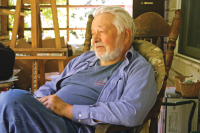A moving ‘Liar’s Bench’ performance
 Editor’s note: Marie Cochran attended the production of the “Liar’s Bench” on June 20 at the Mountain Heritage Center on the WCU campus and wrote this review for The Smoky Mountain News.
Editor’s note: Marie Cochran attended the production of the “Liar’s Bench” on June 20 at the Mountain Heritage Center on the WCU campus and wrote this review for The Smoky Mountain News.
I am very familiar with the term “the Liars Bench” in its practice of casual storytelling among Southern men sitting in the courthouse square and at barbershops; yet I was skeptical to hear this lighthearted phrase associated with the account of 19 Black men who drowned on a chain gang only decades after the Civil War.
As a disclaimer, for the last month I’ve been a witness to the assemblage of information and a participant in debates that raged about the proper way to engage a diverse audience. Yet, I waited like every other audience member wondering whether “Tears in the Rain” would be told as a gruesome ghost story, a sorrowful tale of faceless men who perished in an unfortunate accident, or an insightful portrayal of a human tragedy.
In his welcome remarks, Scott Philyaw, director of the Mountain Heritage Center, informed the audience that this program might be painful and difficult to hear but not unlike a blues song, a sorrowful story to help us to deal with the pain. Gary Carden, founding director of The Liars Bench, crafted a collaborative ensemble of performers who utilized various media to build the emotion in the premiere of “Tears in the Rain” as a work-in-progress.
A documentary short film, “Bring Them Home” by director/producer Dave Waldrop and filmmaker Joe Holt, brought the audience to the actual scene of the drownings and proposed evidence for an examination of the suspected burial site(s). Throughout the evening, a backdrop of compelling photographic portraits of incarcerated workers and trains, assembled by Pam Meisner, curator for the Mountain Heritage Center, was projected onscreen.
Related Items
The extended notes of a lonesome homemade train whistle called to order the dramatic interpretation of the official account. Carden’s narrative set a scene of this historic era by invoking vivid sights and sounds.
“Think of all of the cowboys, the outlaws and the wakeful lovers who have wrapped themselves in that sound! Hear that lonesome whistle blow .... But that is why we are here, to talk about trains and rails, crossties and ... chains .... Black people had been freed from slavery but they needed a way to survive. Suddenly, they had to find a way to wrest a livelihood from the bosom of this wounded earth.”
“They slept in haystacks, abandoned barns and railway boxcars, and they traveled through a landscape that was often desolate, pastures and fallow fields. Everything was temporary ... a week’s work here, sometimes an entire season, and then they were on the road again. Sometimes, they harvested old potatoes and dried beans in abandoned fields. Sometimes, they stole. Eggs, chickens, a corn sheller, sheep shears … maybe a cow. It is an easy thing to do if you are hungry enough .... The jails and prisons of the South grew overcrowded. You could end up on the chain gang simply because you were in a strange town where no one knew you .... The prisons of the South had formed an unholy alliance .... As author Douglas Blackmon’s critically aclaimed work states, it was “Slavery By Another Name.”
A fiery monologue titled “The Prospector” was filled with impassioned descriptions of the treasures of the land coming off the train — reminiscent of a car dealer’s sales pitch and the sermon of a tent revival preacher — was performed by Newt Smith. A recording of “Berta, Berta,” a traditional African American work crew song arranged by Branford Marsalis, played in the background, inserting its own counter narrative of labor, sweat and sadness.
Victoria Casey-McDonald appeared as the surrogate for mothers who mourn their missing sons. Pacing the stage, she sang a potent baritone accapella version of “Steal Away” that had the audience spellbound. By this time, the compelling photographic stares of male black faces on the screen seemed all the more one-dimensional and unsatisfyingly mute. Casey-McDonald summoned the spirits of the deceased men to the stage by calling out some of their names.
Dave Waldrop, Tom Deweese, Newt Smith and Gary Carden recited an imagined dialogue given by four of the 19 men who died that gave voice to their individual experiences on the day of the incident. It was disconcerting to hear these older white men bound into the spotlight answering to an African American woman with the cry “Yes, Mama.” There are plans to recruit African American youth and older men to play these roles in the future.
William Ritter presented a hauntingly beautiful untitled piece of original music. Sitting alone on the stage in a humble manner to “give the song” as old-timers would say — rather than perform it, Ritter accompanied himself with the percussive beat of chains clinched then dropped on the stage, simulating both the sound of workers beating in spikes to lay tracks and the clank of slave shackles.
“Can you hear it? Can you hear it?
That’s the clank and the rattle of the chains.
19 men done laid to rest — are restless, restless
Can you hear it? Can you hear it?
The water comes weeping down down
The tears still fall from the roof of the tunnel
Where 19 men were drowned.
(Chorus)
Mmmm, the tears fall like rain
Fall like blood and leave the stain
The names, of 19 men,
You can hear their cries in the howling wind
Can you hear it? Can you hear it?
The songs of the working dead
Still hauling stones from the heart of the mountain
And painting our progress red.
Can you hear it? Can you hear it?
The clink of steel down deep, deep.
19 men were dragged down together
Shackled forever to sleep.
At the conclusion of the evening, Gary Carden and historian Curtis Wood fielded questions from the audience that pointed out the desire for additional acts of recognition for the tragedy, concerns about insensitivity regarding the value human of life, and cautionary tales about the “price of progress.”
The drowning is widely known about through oral history and documented in newspaper accounts, which noted it as one of the worst tragedies associated with prison laborers in North Carolina. Its resurrection is based on the discovery of a record with the men’s names and ages; plus, the possible discovery of their final resting place.
It is even more poignant when you consider that it is the 85th anniversary of the removal of the church and gravesite of the Mount Zion AME Zion church to make way for the expansion of the Western Carolina University campus. Both stories propel themselves out of local lore into a wider context as we mark the 150th Anniversary of the Emancipation Proclamation giving thoughtful consideration to the complex narrative of our mountain communities.
(Marie T. Cochran is an artist and independent scholar who lives in Jackson County. She is the founding curator of the Affrilachian Artist Project.)









